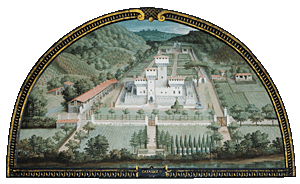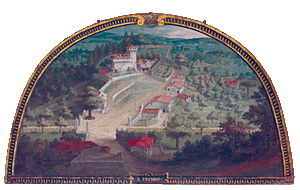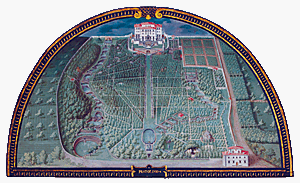In the first two painted images are the roots of a family to be extolled: the dwellings of Trebbio and Cafaggiolo are portrayed there, with their sober architectonic volumes, the boundary walls, the guard towers, the kitchen and the formal gardens, the pergolas set in the rolling green of the landscape.

Michelozzo, the architect
also hired for Bosco ai Frati, worked on both
buildings, transforming the severe fortified residences
into harmonious, humanistic dwellings. The artist had
been called by Cosimo the Elder’s father, Giovanni di
Bicci, to renovate Trebbio Castle after 1426 and the
work was then continued by his son, a great “lover of
building”; instead, the patron at Cafaggiolo between
1431 and 1433 was with all probability Giuliano, the
son of a cousin of Cosimo’s.
Once this branch of the family died out in 1443, the
Cafaggiolo villa passed into Cosimo’s hands who, in
1451, assigned the ancient property of Trebbio to his
nephew Pierfrancesco (his brother Lorenzo’s son) when
he came of age, keeping instead Cafaggiolo for himself.
Here his son Piero and grandsons Giuliano and Lorenzo
grew up, the latter of whom composed there the poem
Nencia da Barberino. And it was Lorenzo the Magnificent
himself, to cede in 1485 the villa of Cafaggiolo to the
secondary branch of the family, already the owners of
Trebbio, where the famous ceramics factory then
flourished, beginning in 1498.

Another Cosimo (the son of
Giovanni delle Bande Nere) would instead leave Trebbio
in 1537, upon receiving the news about the killing of
Alessandro. Barely eighteen years old, he was destined
to become duke and then grand duke of Tuscany. He
brought Florence into the power game of European
absolutism, between France and the Empire, transforming
the artistic passion of his 15th-century predecessors
into a sumptuous celebration of the state’s
magnificence. The ancient dwellings of Trebbio and
Cafaggiolo thus still remained dear but, with their
excessive rusticity, were suitable at most for the
seasonal rite of the hunt.

One of his sons, Francesco,
was to transfer the magnificence of the court into the
frame of a rural residence ‘facing” the ancestral
Mugello, acquiring ‘mountain’ lands in 1568 in the
inaccessible area of Pratolino where he had Bernardo
Buontalenti erect a new, splendid and very modern
villa. Demolished at the beginning of the 19th century
because it was by then abandoned, it concealed in its
relatively simple disposition of volumes, hidden in the
basement, a series of fantastic grottoes, where water
ran setting in motion mechanisms that produced music
and made automatons move, descending from the fountain
of Jove and especially from that of the Apennine (the
mountain territory from which the Medici had descended
centuries before), to then fill other grottoes and
fountains set further downhill in a complex
interrelation between nature and artifice, so dear to
the melancholic grand duke and his beloved Bianca
Cappello.
Trebbio, Cafaggiolo, Pratolino
Cosimo the Elder, Pierfrancesco, Lorenzo the Magnificent, Grand Duke Francesco I